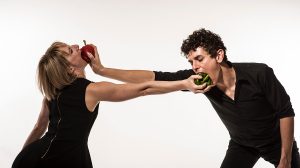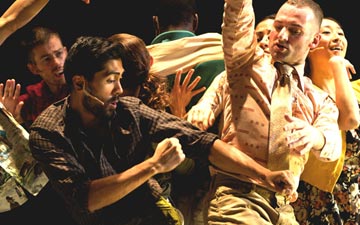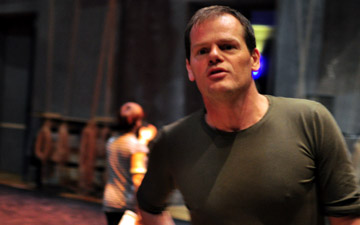
© Alicia Clarke. (Click image for larger version)
Protein
May Contain Food
★★★★✰
London, The Place
21 April 2016
www.proteindance.co.uk
www.theplace.org.uk
The optimum number of chews in the mastication of a cherry tomato is 21. This was just one of the foodie facts that I learned during this epicurean epic; Protein’s latest foray into the hybrid potential of musical theatre and dance. Other little gems included always searing your beef and peeling an onion while holding a spoon in your mouth; amongst tips that also veered towards the erotic with teasing references to it being “OK to swallow sometimes” and “don’t pop your cherry prematurely”.
New work from the creative labyrinth of Luca Silvestrini’s psyche comes around infrequently but it is always big, bold and intuitively relevant to our times. Former artistic intentions have targeted psychoanalysis (On the Couch); binge culture (Publife); avaricious consumerism (The Big Sale); hedonistic battles with our physical appearance (Dear Body); social media (LOL); and – most recently – migration (Border Tales). Silvestrini’s body of work appears to be a tour of momentous issues in the social history of the 21st Century. If there is a thorny subject to grasp, then Silvestrini has the unerring talent to wrestle it into a capsule of dance theatre with a narrative theme that hits the issue hard. He makes audiences happy and sad but leaves us thinking about that narrative intention long after the music has ended.
His latest target is our obsession with food. Nothing new in that, you might assert, but he makes it relevant to today with references to every modern food fad and philosophy imaginable: from the evangelical mantra of veganism (“never put any substance into your mouth that once had life”, one of his characters says, repeatedly) to the destruction of the ozone layer by mass farming. His food-fest occasionally takes on the sensual, pre-orgiastic feel of Le Grande Bouffe (although, here, it’s just the waiters that indulge)! There is even a sung debate about the Big Bang Theory versus God. And yet, the heavy stuff is always seasoned with lashings of relevant humour, a notable trademark of the Protein repertoire.
Collaboration has always been a feature in the development of Silvestrini’s artistic intentions and he shares the creative credit for May Contain Food with the composer, Orlando Gough, who not only contributed the operatic score but also the recipes for the bite-sized delicacies served to the audience during the show. As well as writing music, it turns out that Gough has also published a cookbook and his interest in the political, social and cultural aspects of eating must have synergised happily with Silvestrini’s purpose. Gough’s score is outstanding, superbly performed, in a work that has dancers and singers interacting seamlessly and on equal terms.
The Place’s Robin Howard Theatre is transformed into a restaurant with several round dining tables for the audience, each adorned by some fancy table decoration. Mine had a cloth that was an animal skin – happily, fake – onto which little deer-like horns had been sown. If, after midday, the faun were ever shot and skinned, the end product would no doubt appear quite like this table cloth. A horrid thought but nonetheless one that seemed to resonate with the fanciful notions of the show.
The performance has three spatial dimensions, taking place “in-the-round” in the circular area between tables; by the performers’ promenading – as waiters – amongst the audience; and standing against a far wall, proscenium-style, onto which a cafeteria clock is installed, showing real-time progress. Since this setting greatly reduces the theatre’s capacity, the show – like the dining car of the Orient Express – has two sittings, nightly (respectively, at 7 and 9pm). The prominence of the clock draws attention to time and, at around an hour and forty-five minutes, this is a show that definitely contains a little excess fat that could be trimmed. A couple of the sequences add little to the overall impact and could be lost to improve the whole.
The eight performers synergistically split into groups of four in differing forms of sub-division: by gender; by the primacy of discipline (essentially as dancers, or singers/musicians, although the dancers sing, and singers also dance); and in terms of age. And these other groups also have equality in their mix of genders. Each performer brings something extra special to the work and each has a “spotlight” solo, whether of song, dance or text. The ensemble sustains an impressive level of energy in a long and busy evening; doubly so, since they have to do it all over again after the briefest of rests. Their impressive dynamism is sustained through the mix of an intimate interaction with the audience and the close integration of the cast.
Martin George has mastered the unique mix of authority and servitude that distinguishes the Maître D’, in the style of the butler at Downton: that is, until he loses it in a long monologue, first professing the sensual and delicious qualities of certain foodstuffs before ranting about the inadequacy of the examples handed to him. His angry denouncement of the awfulness of a “condom-clad” cucumber establishes a leg-crossing imagery – redolent of John Bobbitt’s unfortunate dismemberment – when the offending article is ripped in half and thrown at the back wall.
The four principal dancers are Sonya Cullingford (so impressive recently in Will Tuckett’s Elizabeth), Saara Hurme – these two inexplicably stripping down to their bras for one long dance sequence – plus Matthew Winston and Carl Harrison, who provided much of the humour as the “cheeky-chappie” waiter; the one that diners need to keep an eye on! Michael Henry (also the music director), Louise Sofield and Donna Lennard were outstanding as promenading vocalists who also danced and waited on tables.
Doing food in dance is not in itself innovative. For example, I recall Shobana Jeyasingh’s Just Add Water from 2009 so well that I’m still cooking her recipe for Zanzibari Prawns! However, I have no prior experience of theatre that combines music, dance, text and taste amongst its sensations. The menu of Gough’s delicious gastronomic contribution ranges from the simplicity of the aforementioned cherry tomato (and it seems that they really do disappear into juice after exactly 21 chews – try it for yourself); to the structural genius of perfectly-formed balls of rice, held together with sesame seeds; crisply-fried kale; and a tiny square of sticky ginger pudding. It’s a cheap date with theatre and dinner combined!
Like these tasty morsels, May Contain Food is a delightful selection of amuse-bouches. An absorbing smorgasbord of food-related ideas and issues, containing humour, pathos and sensuality. Ever given a red pepper the kiss of life? Slipped a ball of rice into a stranger’s mouth? Or, rolled a cherry tomato over your face and lips, to settle gently in your eye-socket? If you have missed out on these and other sensory, gourmandise experiences that go some way beyond taste, then it might be time to add some Protein to your diet.

















You must be logged in to post a comment.